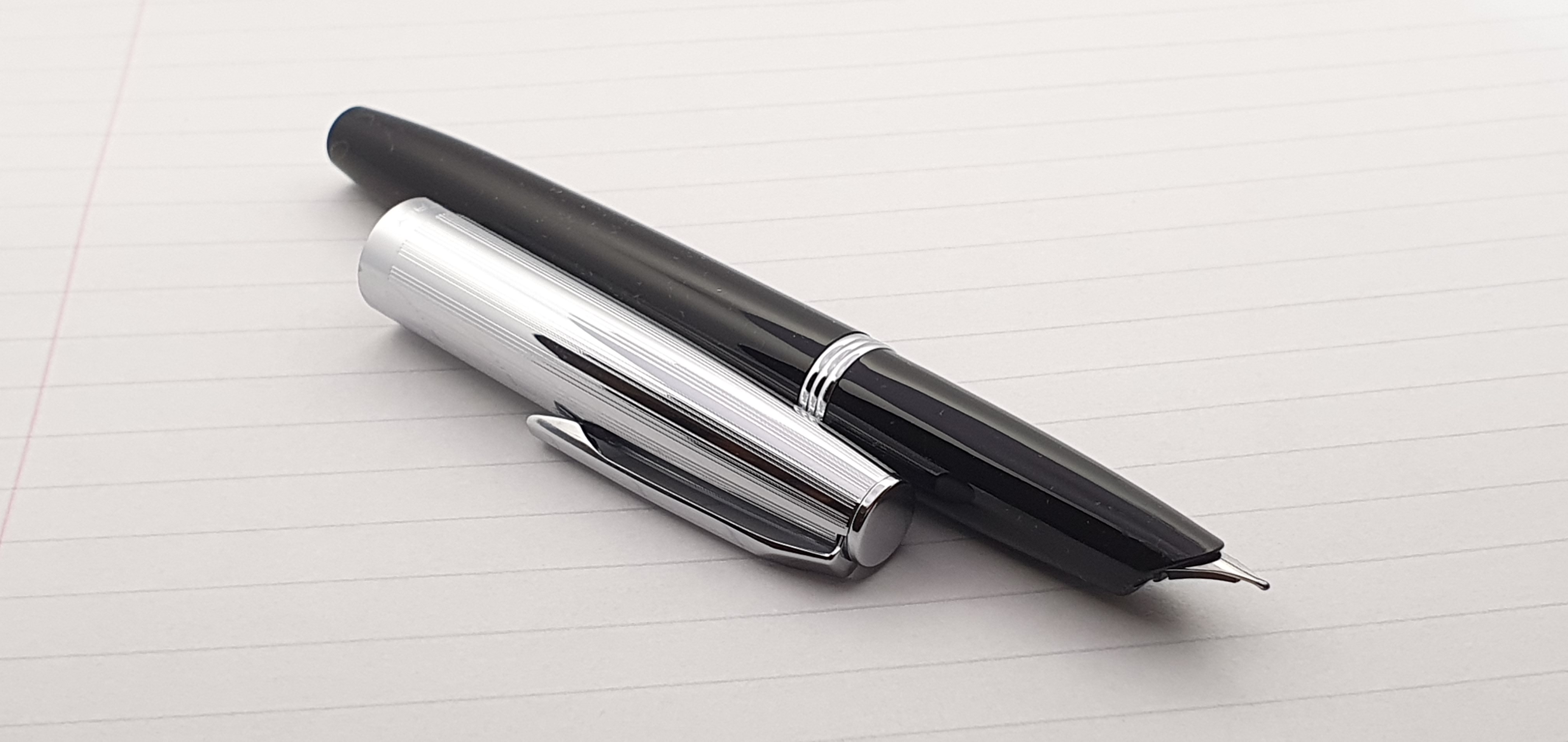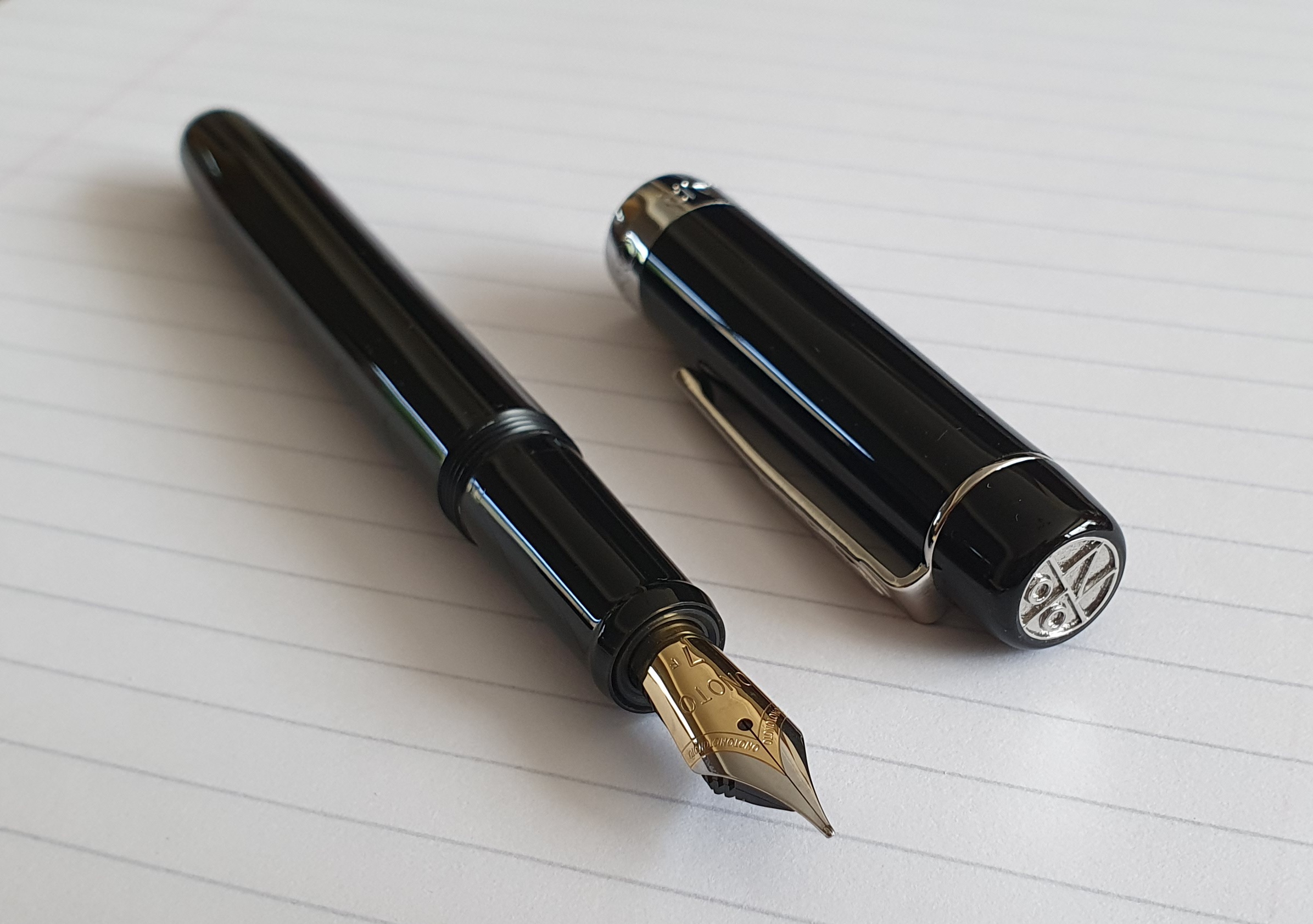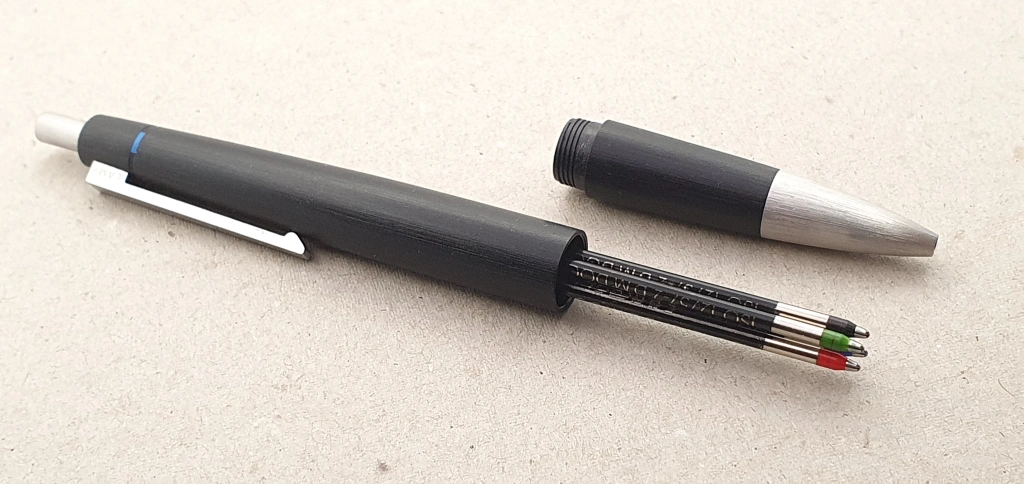For the past three weeks, I have been getting acquainted with the pens I bought at the London Pen Show, some old and some new. Coming home with seven pens for myself (the eighth was to be a gift), I have enjoyed inking the new arrivals and trying them all out.
One of the these was the Aurora Duo Cart. I had been interested in this model for a few years since first learning of it, possibly through the favourable review by Anthony on UK FountainPens in 2019. More information can be found on another positive review also in 2019 by The Gentleman Stationer.
I am a late comer to this pen. I had pondered buying one online a few times, but it was spotting one for sale on Kirit Dal’s tables at the recent pen show, one of his test samples being sold off at half price, that finally made me buy.

This is a cartridge-converter pen, in black resin with a shiny metal cap and a distinctive hooded steel nib. It was introduced a few years ago and is part of Aurora’s current range but has its origins in the Aurora 88 designed in 1947 by Marcello Nizzoli. I do not have such a pen to compare but have read that it was 145mm long when uncapped, had an 18k gold nib and was a plunger filler with some form of ink window. It was therefore longer than the modern Duo Cart but the subtle contours of the grip section and the hooded nib look very similar.

According to Aurora’s web site, the Duo Cart collection was inspired by the 1950’s and reinterprets the style of that period, with its tapered shape typical of those years. I understand that the name Duo Cart was taken from another vintage Aurora model, which carried two ink cartridges. The current Duo Cart is sold at 165 euros with the silver coloured nib and cap, or 190 euros for the version with a gold coloured nib and cap.

For me, the beauty of the Duo Cart lies in its profile, the gentle tapering of the section towards the hooded nib, the curvature of the hood itself with its striking parabola of resin, partly covering the nib and then, viewed from the side, the curved cutaway and the curved plastic feed. The tapering is matched at the opposite end in a truncated bullet-shape barrel with a shiny metal disc inset at the base. The pen looks and feels good in the hand and looks good on a table.

The metal cap has a flat top, a straight, guilloche design, and a springy pocket clip. The cap bears the name Aurora and the words “Made in Italy” in capital letters in a style also redolent of the 1950’s.
The cap is friction fit but fits very snuggly and securely, and makes a little pop as it is removed. As the cap material is so thin, the cap and barrel are almost flush when the the pen is capped.
The nib.
The steel nib has no visible markings but is a medium. The tipping, when viewed head on, is rounded making for a rather small sweet spot and a line that is on the fine side for a medium. It feels firm and this, together with the absence of a flattened (or stubby) surface for contact with the paper, means that there is little line variation between down strokes and cross strokes. Mine was set up well but I also flossed and smoothed the nib just a little, to try to improve ink flow and lubrication.

Filling.
The barrel unscrews on plastic threads. The barrel is of resin but inside the barrel, a brass liner can be seen. The pen takes Aurora’s proprietary cartridges. These can be rather difficult to come by in the UK. My pen, having been a rep’s sample, came without box, papers or any cartridge or converter. I did have some Aurora cartridges at home, which had come with the purchase of an Aurora Talentum, so I inserted one of these. I could syringe-fill these until I find some new ones. However, the good news is that the Aurora cartridge fitting is compatible with Parker Quink cartridges. This means that Parker converters may also be used although this also depends on their girth. I have a selection of Parker converters gathered over the years. One of the squeeze bar models did not fit. Although the coupling was compatible, the barrel would not go over the wide girth of the converter.

Size and weight.
The Duo Cart is a smallish pen, at around 134mm long when capped. Uncapped it is just 119mm long. With cap posted the length is 140mm, but the cap does not feel very secure. I have been cautious of pushing the cap on to the barrel too hard. However I have quickly got into the habit of using the pen unposted. It weighs about 25g, or about 14g uncapped and 11g for the cap alone.
Concluding thoughts.
I am very taken by the vintage styling of the pen, with its modern materials. I enjoy holding and writing with it. It works best in my lefty-underwriter style. I am also glad to be able to use it with Parker cartridges or converters. I would like the pen even more if I had better handwriting and a more conventional writing style. As a person who is predominantly a lefty over-writer, I have found in recent years that oblique nibs are a benefit for me. It is not the most forgiving of pens to use as the nib has a narrow sweet-spot. I think this will improve with use.
That said, I am glad to have bought the Duo Cart. Rather like the classic Citroen DS, it is refreshingly different.

Edit: 26 March 2023: For an in-depth account of the vintage Aurora 88 family, please see the post on Matspens Vintage Aurora 88 Family Ultra Review.



















